#european southern observatory
Photo

Hidden fires of Flame Nebula
#space#astronomy#stars#astrophotography#flame nebula#ngc 2024#galaxy#nebula#planet#cosmos#planets#universe#night sky#solar system#ESO#european southern observatory
2K notes
·
View notes
Text
Japanese X-Ray Satellite to Probe Universe's Largest Structures
A revolutionary satellite is preparing to take to the skies, viewing the hidden parts of cosmos in a new light to reveal stellar explosions and powerful jets streaming from supermassive black holes.
First Full-Color Images From Webb Space Telescope
XRISM (X-ray Imaging and Spectroscopy Mission), a joint mission between the Japan Aerospace Exploration Agency (JAXA) and NASA, is designed to…
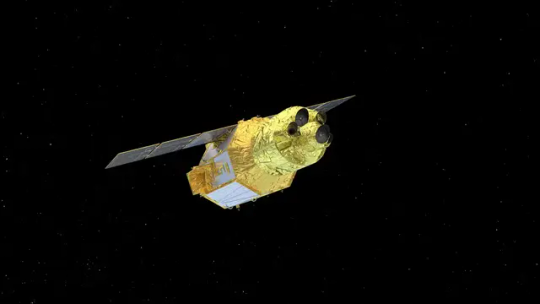
View On WordPress
#European Southern Observatory#Explorers Program#Gizmodo#In spaceflight#Internet#JAXA#Mihoko Yukita#NASA#Ray#Richard Kelley#Smart Lander for Investigating Moon#Space telescopes#Supermassive black hole#Technology#X-ray astronomy satellite#X-Ray Imaging and Spectroscopy Mission#X-ray telescopes
3 notes
·
View notes
Text
Groundbreaking Survey Reveals Secrets of Planet Birth Around Dozens of Stars - Technology Org
New Post has been published on https://thedigitalinsider.com/groundbreaking-survey-reveals-secrets-of-planet-birth-around-dozens-of-stars-technology-org/
Groundbreaking Survey Reveals Secrets of Planet Birth Around Dozens of Stars - Technology Org
In a series of studies, a team of astronomers led by Per-Gunnar Valegård has shed new light on the fascinating and complex process of planet formation.
One of the studies were led by Per-Gunnar Valegård, a doctoral student at the University of Amsterdam. The stunning images, captured using the European Southern Observatory’s Very Large Telescope (ESO’s VLT) in Chile, represent one of the largest ever surveys of planet-forming discs.
The research brings together observations of more than 80 young stars that might have planets forming around them, providing astronomers with a wealth of data and unique insights into how planets arise in different regions of our galaxy.
Planet-forming discs. Image credit: ESO/C. Ginski, A. Garufi, P.-G. Valegård et al.
“This is really a shift in our field of study,” says Christian Ginski, who was formerly a postdoc at the University of Amsterdam, currently a lecturer at the University of Galway, Ireland, and lead author of one of three new papers published in Astronomy & Astrophysics. “We’ve gone from the intense study of individual star systems to this huge overview of entire star-forming regions.”
To date more than 5000 planets have been discovered orbiting stars other than the Sun, often within systems markedly different from our own Solar System. To understand where and how this diversity arises, astronomers must observe the dust- and gas-rich discs that envelop young stars — the very cradles of planet formation. These are best found in huge gas clouds where the stars themselves are forming.
Much like mature planetary systems, the new images showcase the extraordinary diversity of planet-forming discs. “Some of these discs show huge spiral arms, presumably driven by the intricate ballet of orbiting planets,” says Ginski. “Others show rings and large cavities carved out by forming planets, while yet others seem smooth and almost dormant among all this bustle of activity,” adds Antonio Garufi, an astronomer at the Arcetri Astrophysical Observatory, Italian National Institute for Astrophysics (INAF), and lead author of one of the papers.
The team studied a total of 86 stars across three different star-forming regions of our galaxy: Taurus and Chamaeleon I, both around 600 light-years from Earth, and Orion, a gas-rich cloud about 1600 light-years from us that is known to be the birthplace of several stars more massive than the Sun. The observations were gathered by a large international team, comprising scientists from more than 10 countries.
The team was able to glean several key insights from the dataset. For example, in Orion they found that stars in groups of two or more were less likely to have large planet-forming discs. This is a significant result given that, unlike our Sun, most stars in our galaxy have companions. As well as this, the uneven appearance of the discs in this region suggests the possibility of massive planets embedded within them, which could be causing the discs to warp and become misaligned.
While planet-forming discs can extend for distances hundreds of times greater than the distance between Earth and the Sun, their location several hundreds of light-years from us makes them appear as tiny pinpricks in the night sky. To observe the discs, the team employed the sophisticated Spectro-Polarimetric High-contrast Exoplanet REsearch instrument (SPHERE) mounted on ESO’s VLT.
SPHERE’s state-of-the-art extreme adaptive optics system corrects for the turbulent effects of Earth’s atmosphere, yielding crisp images of the discs. This meant the team were able to image discs around stars with masses as low as half the mass of the Sun, which are typically too faint for most other instruments available today.
Additional data for the survey were obtained using the VLT’s X-shooter instrument, which allowed astronomers to determine how young and how massive the stars are. The Atacama Large Millimeter/submillimeter Array (ALMA), in which ESO is a partner, on the other hand, helped the team understand more about the amount of dust surrounding some of the stars.
As technology advances, the team hopes to delve even deeper into the heart of planet-forming systems. The large 39-metre mirror of ESO’s forthcoming Extremely Large Telescope (ELT), for example, will enable the team to study the innermost regions around young stars, where rocky planets like our own might be forming.
For now, these spectacular images provide researchers with a treasure trove of data to help unpick the mysteries of planet formation. “It is almost poetic that the processes that mark the start of the journey towards forming planets and ultimately life in our own Solar System should be so beautiful,” concludes Per-Gunnar Valegård, a doctoral student at the University of Amsterdam, the Netherlands, who led the Orion study. Valegård, who is also a part-time teacher at the International School Hilversum in the Netherlands, hopes the images will inspire his pupils to become scientists in the future.
Source: University of Amsterdam
You can offer your link to a page which is relevant to the topic of this post.
#ALMA#amp#Art#Astronomy#Astronomy news#Astrophysics#atmosphere#Cloud#clouds#data#diversity#dust#earth#Earth’s atmosphere#effects#elt#employed#European Southern Observatory#exoplanet#Featured Space news#formation of planets#Fundamental physics news#Future#Galaxy#gas#hand#heart#how#images#insights
0 notes
Text
Paranal Observatory - The world-class "astronomical eyes" on Cerro Paranal
Paranal Observatory – The world-class “astronomical eyes” on Cerro Paranal
An observatory operated by the European Southern Observatory (ESO). By total light-collecting area, it is the largest optical-infrared observatory in the Southern Hemisphere. The Very Large Telescope (VLT), is composed of four separate 8 meter telescopes and four auxiliary telescopes of 1.8 meter each, which are also part of the astronomical interferometer (VLTI) to make it available when the…

View On WordPress
#Cerro Paranal#ESO#European Southern Observatory#Observatory#Paranal Observatory#telescope#Very Large Telescope
0 notes
Text
Here is the first image of the giant black hole in the center of the Milky Way!
Here is the first image of the giant black hole in the center of the Milky Way!
4 p.m. And here is a comparison of the two black holes from which we were able to obtain images, M87* and Sagittarius A*! ” We have two completely different types of galaxies and two masses very different black holes, but near the edge of these black holes they look surprisingly similar “says Sera Markoff in the communicated of the CNRS, co-president of the scientific council of the EHT and…

View On WordPress
#Astronomy#central black hole#central black hole of the Milky Way#European Southern Observatory#Event Horizon Telescope#sagittarius A*#supermassive black hole
0 notes
Photo
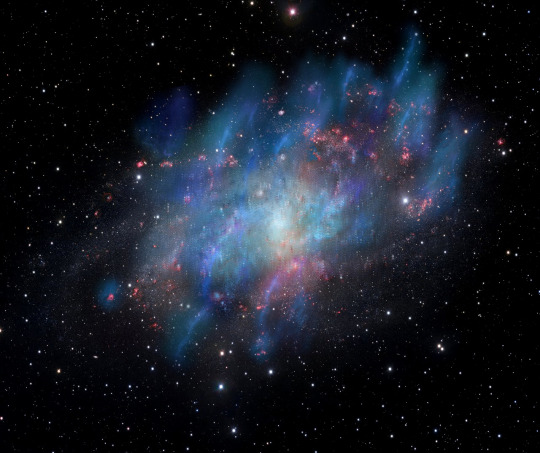
Cosmic ray-driven winds superimposed on visible light image of Triangulum galaxy M33
Artist's illustration of cosmic ray-driven winds (blue and green) superimposed on a visible light image of the Triangulum galaxy M33 (red and white), observed with the VLT Survey Telescope at the European Southern Observatory’s Paranal Observatory in Chile.
Credit: Institute for Research in Fundamental Sciences- IPM/European Southern Observatory
#institute for research in fundamental sciences - ipm/european southern observatory#chile#cosmic ray-driven winds#triangulum galaxy#space#astronomy#nature
18 notes
·
View notes
Link
The Space, Astronomy & Science Podcast.
SpaceTime Series 27 Episode 26
*The Brightest and Fastest Growing Black Hole Quasar Ever Seen
Astronomers have uncovered a cosmic colossus: the most luminous quasar known, powered by a black hole 17 billion times the mass of the Sun and growing at a staggering rate. The quasar J0529-4351, situated over 12 billion light-years away, is a beacon from the early universe, challenging our understanding of black hole formation and growth.
*Supernova 1987A's Hidden Heart: The Neutron Star Within
NASA's Webb Space Telescope has pierced through the dusty veil of Supernova 1987A, revealing emissions indicative of a neutron star's presence. This discovery resolves a long-standing debate and provides a glimpse into the violent stellar processes that forge these dense remnants.
*Surviving the Cosmic Rays: Earth's First Life and the Shield of Manganese
How did life's early building blocks endure Earth's intense radiation? New research suggests that cell-like structures with manganese-based antioxidants could have been life's ancient protectors, enabling the survival and evolution of the first organisms in a gamma-ray-blasted world.
*Leap Year Explained: Why February Gains an Extra Day
As February 29 approaches, we demystify the leap year phenomenon. Learn how this calendrical correction ensures our timekeeping stays in harmony with Earth's orbit, and discover the historical and astronomical significance behind the extra day in February.
Join us on SpaceTime as we delve into the depths of black holes, witness the aftermath of stellar explosions, and explore the primordial resilience of life on our planet. Tune in for a journey through the cosmos and the intricacies of our celestial calendar.
Listen to SpaceTime on your favorite podcast app with our universal listen link: https://spacetimewithstuartgary.com/listen and access show links via https://linktr.ee/biteszHQ
For more SpaceTime and show links: https://linktr.ee/biteszHQ
For more space and astronomy podcasts visit our HQ at https://bitesz.com
Become a supporter of this podcast: https://www.spreaker.com/podcast/spacetime-with-stuart-gary--2458531/support.
#accretion#active#astronomy#black#disc#european#event#galactic#hole#horizon#learning#machine#nuclei#observatory#quasar#samuel#southern#speeds#superluminal#supermassive
2 notes
·
View notes
Photo

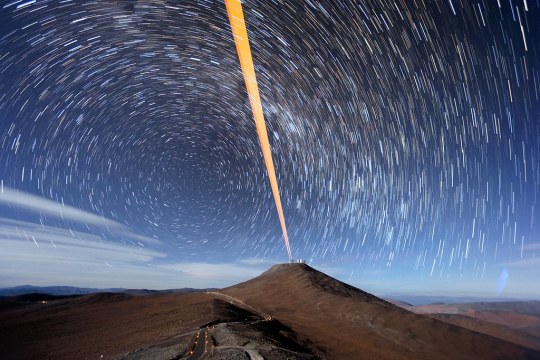




by European Southern Observatory
1K notes
·
View notes
Photo
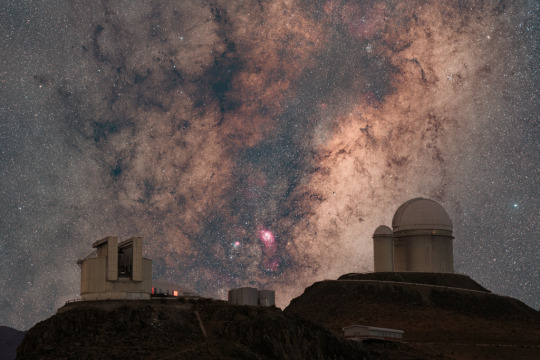
2023 December 1
Milky Way Rising
Image Credit & Copyright: José Rodrigues
Explanation: The core of the Milky Way is rising beyond the Chilean mountain-top La Silla Observatory in this deep night skyscape. Seen toward the constellation Sagittarius, our home galaxy's center is flanked on the left, by the European Southern Observatory's New Technology Telescope which pioneered the use of active optics to accurately control the shape of large telescope mirrors. To the right stands the ESO 3.6-meter Telescope, home of the exoplanet hunting HARPS and NIRPS spectrographs. Between them, the galaxy's central bulge is filled with obscuring clouds of interstellar dust, bright stars, clusters, and nebulae. Prominent reddish hydrogen emission from the star-forming Lagoon Nebula, M8, is near center. The Trifid Nebula, M20, combines blue light of a dusty reflection nebula with reddish emission just left of the cosmic Lagoon. Both are popular stops on telescopic tours of the galactic center. The composited image is a stack of separate exposures for ground and sky made in April 2023, all captured consecutively with the same framing and camera equipment.
∞ Source: apod.nasa.gov/apod/ap231201.html
180 notes
·
View notes
Text
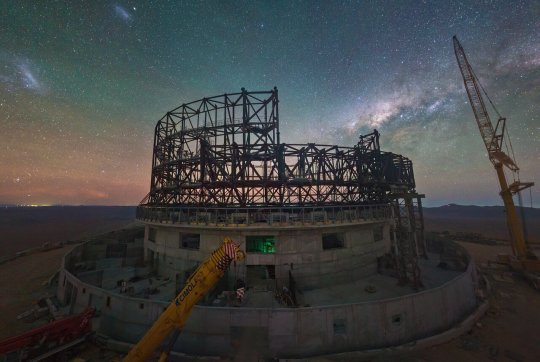
The European Southern Observatory’s Extremely Large Telescope (ESO’s ELT) is a revolutionary ground-based telescope that will have a 39-metre main mirror and will be the largest telescope in the world for visible and infrared light: the world’s biggest eye on the sky. Construction of this technically complex project is advancing at a good pace, with the ELT now surpassing the 50% complete milestone.
Credit: ESO
311 notes
·
View notes
Text
The Very Large Telescope in Chile has photographed a planet orbiting a star in a multi-star system located some 480 light-years from Earth.
The exoplanet, 15 times more massive than our solar system's largest planet Jupiter, orbits a small star that itself orbits a larger star. Also orbiting the larger star is a brown dwarf, or "failed" star. Brown dwarfs are given such a gloomy moniker because these objects are not massive enough to sustain nuclear fusion in their cores like typical stars do, but are still too large to be called planets.
The system of the two stars and the brown dwarf, collectively called HIP 81208, has been known to astronomers for a long time. But the existence of an exoplanet in orbit of the smaller star came as a surprise to astronomers who recently re-examined images of the system taken earlier by the European Southern Observatory's (ESO) Very Large Telescope in Chile.
The newly discovered exoplanet is also quite massive, nearly large enough to be called a brown dwarf itself.
Continue Reading.
96 notes
·
View notes
Text
HOW DO ASTRONOMERS DETECT EXOPLANETS AND DETERMINE IF THEY COULD SUPPORT LIFE??
Blog#335
Wednesday, September 27th, 2023
Welcome back,
On March 21, NASA announced the confirmation of the 5,000th planet outside our Solar System. From scorching-hot gas giants nestled near their parent star to rocky worlds that may host water on their surface, there’s a variety for scientists to study.
But finding these strange new worlds is a science in itself.

We’ve only been able to definitively detect planets of any kind for a few decades, and even at that, there are challenges in detecting such a small object at that distance in even the most powerful telescopes.
Inverse spoke with Marie-Eve Naud, an exoplanet researcher and outreach coordinator for the University of Montreal’s Institute for Research on Exoplanets, to tell us more about how astronomers find these worlds and the considerations for each method.

While there are numerous methods, the ones cited below are the most common.
THE TRANSIT METHOD
Astronomers have discovered most exoplanets using the transit method, notably with NASA's Kepler telescope launched in 2009. This method observes planets as they pass in front of their stars, causing a slight dimming of starlight, which photometers can detect. This approach works best in space due to minimal atmospheric interference, favored by missions like ESA's Cheops and NASA's TESS.

To confirm exoplanets, multiple transits are necessary to rule out sunspots or dust as causes of light fluctuations. Typically, two or three transits are required to gather substantial data.
Once a planet is detected, astronomers can estimate its radius, while mass is often determined through the radial velocity method. The combination of mass and radius helps classify a planet as rocky or gaseous, impacting its potential habitability.
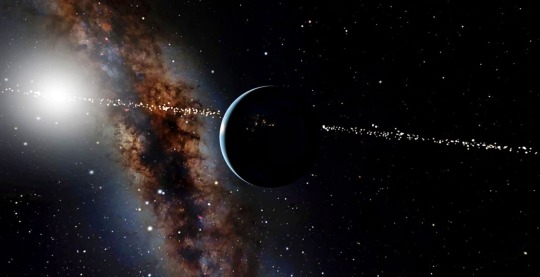
Factors like proximity to an active star and radiation levels also affect habitability assessments, as seen with TRAPPIST-1's uncertain habitability despite hosting seven Earth-sized planets in its habitable zone.
RADIAL-VELOCITY METHOD
The radial velocity method is commonly used to discover planets, particularly with instruments like HARPS at the European Southern Observatory’s La Silla 3.6m telescope in Chile.

Planets and stars both orbit around their center of mass. A star with a planet exhibits a slight motion. Multiple planets can lead to complex motions.
This method involves analyzing the star's spectrum. When the star approaches, its light shifts towards red due to compression. When it moves away, the light shifts towards blue.

The planet's motion slightly affects the star's spectrum, creating a "barcode" of the star.
The first detection of a planet around a Sun-like star using this method was in 1995 when Didier Queloz and Michel Mayor found 51 Pegasi b. Prior to that, in 1992, planets were detected around pulsar PSR B1257+12, using changes in the pulsar's radio signal. This showcases the diverse scientific approaches to discovering distant worlds.
Originally published on www.inverse.com
COMING UP!!
(Saturday, September 30th, 2023)
"WHAT IS THE BLOCK THEORY??"
#astronomy#outer space#alternate universe#astrophysics#universe#spacecraft#white universe#space#parallel universe#astrophotography#dwarf planet#planets#come to the dark side#dark energy#cosmology#cosmos#big bang comics
138 notes
·
View notes
Text
Astronomers reveal a new link between water and planet formation - Technology Org
New Post has been published on https://thedigitalinsider.com/astronomers-reveal-a-new-link-between-water-and-planet-formation-technology-org/
Astronomers reveal a new link between water and planet formation - Technology Org
Researchers have found water vapour in the disc around a young star, which is exactly where planets may be forming.
Water is a key ingredient for life on Earth and is also thought to play a significant role in planet formation, yet, until now, astronomers have never been able to map how water is distributed in a stable, cool disc — the type of disc that offers the most favourable conditions for planets to form around stars.
For the first time, astronomers have weighed the amount of water vapour around a typical planet-forming star.
The new findings were made possible thanks to the Atacama Large Millimeter/submillimeter Array (ALMA) – a collection of telescopes in the Chilean Atacama Desert. The University of Manchester’s Jodrell Bank Centre for Astrophysics hosts the UK ALMA Regional Centre Node (UK ARC) which supports UK astronomers using ALMA.
Dr Anita Richards, Senior Visiting Fellow at The University of Manchester and previously a member of the UK ARC, played a key role in verifying the operation of the ‘Band 5’ receiver system, which was essential for ALMA to produce a detailed image of the water.
The observations, published in the journal Nature Astronomy, reveal at least three times as much water as in all of Earth’s oceans in the inner disc of the young Sun-like star HL Tauri, located 450 light-years away from Earth in the constellation Taurus.
Stefano Facchini, an astronomer at the University of Milan, Italy, who led the study, said: “I had never imagined that we could capture an image of oceans of water vapour in the same region where a planet is likely forming.”
Co-author Leonardo Testi, an astronomer at the University of Bologna, Italy, added: “It is truly remarkable that we can not only detect but also capture detailed images and spatially resolve water vapour at a distance of 450 light-years from us.”
These observations with ALMA, which show details as small as human hair at a kilometre distance, allow astronomers to determine water distribution in different disc regions.
A significant amount of water was found in the region where a known gap in the HL Tauri disc exists – a place where a planet could potentially be forming. Radial gaps are carved out in gas- and dust-rich discs by orbiting young planet-like bodies as they gather up material and grow. This suggests that this water vapour could affect the chemical composition of planets forming in those regions.
But, observing water with a ground-based telescope is no mean feat as the abundant water vapour in Earth’s atmosphere degrades the astronomical signals.
ALMA, operated by the European Southern Observatory (ESO) and its international partners, is located at about 5000 metres elevation and is built in a high and dry environment specifically to minimise this degradation, providing exceptional observing conditions. To date, ALMA is the only facility able to map water distribution in a cool planet-forming disc.
The dust grains that make up a disc are the seeds of planet formation, colliding and clumping into ever larger bodies orbiting the star. Astronomers believe that where it is cold enough for water to freeze onto dust particles, things stick together more efficiently — an ideal spot for planet formation.
Members of the UK ARC are contributing to a major upgrade of ALMA, which, with ESO’s Extremely Large Telescope (ELT) also coming online within the decade, will provide even clearer views of planet formation and water’s role. In particular METIS, the Mid-infrared ELT Imager and Spectrograph, will give astronomers unrivalled views of the inner regions of planet-forming discs, where planets like Earth form.
Source: University of Manchester
You can offer your link to a page which is relevant to the topic of this post.
#ALMA#arc#Astronomy#Astronomy news#Astrophysics#atmosphere#Capture#chemical#chemical compositions#Composition#details#dust#earth#Earth’s atmosphere#elt#Environment#European Southern Observatory#form#formation of planets#freeze#Fundamental physics news#gap#gas#how#human#images#it#Italy#LED#life
0 notes
Text
Stars orbiting the black hole in the center of our galaxy
This is a timelapse of 20 years of observations from the European Southern Observatory's Very Large Telescope looking at stars in orbit around the black hole at the center of our own galaxy, called Sagittarius A*. And yes, the stars - some more massive than our sun - orbit the black hole, like our planet orbits the sun. (The black hole isn't seen in this image. But look at the center of the image to see a star doing a complete loop around an empty bit of space.)
#astronomy#nasa#astronomers#universe#astrophotography#nasa photos#astrophysics#outer space#nasawebb#hubble space telescope#european#telescope#just an observation#i love astronomy#astrography#astro notes#astro community#astro observations#astroblr#astrology observations#astro boy#space program#space science#space exploration#space#international space station#planetary science#science#science facts#solar system
45 notes
·
View notes
Text

Betelgeuse (European Southern Observatory / L. Calçada)
124 notes
·
View notes
Photo
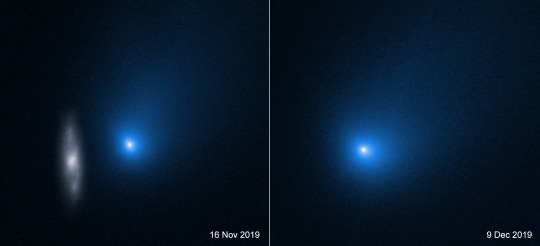
Interstellar Comet 2I Borisov : From somewhere else in the Milky Way galaxy, Comet 2I/Borisov was just visiting the Solar System. Discovered by amateur astronomer Gennady Borisov on August 30, 2019, the first known interstellar comet is seen in these two Hubble Space Telescope images from November and December 2019. On the left, a distant background galaxy near the line-of-sight to Borisov is blurred as Hubble tracked the speeding comet and dust tail about 327 million kilometers from Earth. At right, 2I/Borisov appears shortly after perihelion, its closest approach to Sun. European Southern Observatory observations indicate that this comet may never have passed close to any star before its 2019 perihelion passage. Borisov's closest approach to our fair planet, a distance of about 290 million kilometers, came on December 28, 2019. Even though Hubble's sharp images don't resolve the comet's nucleus, they did lead to estimates of less than 1 kilometer for its diameter. via NASA
330 notes
·
View notes